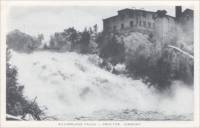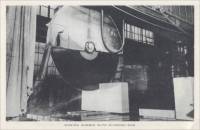


List of Quarries
in Vermont & Quarry
Links, Photographs and Articles
Proctor Vermont – Vermont Marble Co.
(Later a part of the Producers’ Marble Co.)
- Producers’ Marble Company’s Illustrated Catalogs of 1886, ’87 and ’89 – This Book Contains Eighty-four Choice Designs Selected from the Late Producers’ Marble Company’s Illustrated Catalogs of 1886, ’87 and ’89, D. H. Dickinag (?), Water Street, Chicago, Illinois, June, 1889.
- Proctor, Vermont – the Vermont Marble Company – Symbols of Service Monumental Catalog & Price List, Vermont Marble Co., Proctor, Vermont, 1919. (A few of the images in this book are shown below.)
 |
 |
 |
Front cover of Symbols of Service, one of the monumental catalogs by the Vermont Marble Co., Proctor, Vermont |
Sample page of a monument to a soldier in Symbols of Service |
Sample page of a monument to a soldier in Symbols of Service |
 |
 |
 |
Photograph of one side of this 1776 cemetery stone belonging to Lt. Col. Joseph Wait, and officer in the American Revolutionary War |
“This slab was raised on a Vermont farm soon after the Declaration of Independence was signed.” (Carved side of this 1776 cemetery stone belonging to Lt. Col. Joseph Wait show to the left.) |
Sample page of a monument to a soldier in Symbols of Service |
-
Proctor, Vermont – the Vermont Marble Company (Advertisement from The Monumental News, Vol. XXXIII, No. 1, January 1921, pp. 7)
-
Proctor, Vermont – Vermont Marble Company (Advertisement in The Monument and Cemetery Review, October 1926, pp. iv)
Great Solid facts
Hawthorne, the American writer, said this about one of the huge marble shafts of antiquity:
“It is a great solid fact of past, making Old Rome actually visible to the touch and eye; and no study of history, nor force of thought, nor magic of song can so vitally assure us that Rome once existed as this sturdy specimen of what its rulers and people wrought….”
The Vermont marble columns of the Lyons Memorial are great solid facts, set forth in Riverside Cemetery, Rochester, N.Y., by the Leland-Weston-Lowe Company. They will remain impressive through the ages.
- Proctor, Vermont – the Vermont Marble Company – The Memory Stone 1768-1926, Vermont Marble Co., Proctor, Vermont.
- Proctor, Vermont – the Vermont Marble Company – The Book of Vermont Marble: A Reference for Architects and Builders, published by the Vermont Marble Company, Proctor, Vermont, Third edition, 1929. (You can view this book using the link above on our web site, or you can view the book in other formats on the Internet Archive – Texts.)
Vermont Marble Co., Proctor, Vermont
 |
 |
 |
Front cover of The Book of Vermont Marble |
“The William H. Porter Mausoleum, Woodlawn Cemetery, New York, as it looked in the early stages of construction. Trowbridge & Livingston, Architects.” |
“This recent photo (circa 1929) of the old Custom House, Erie, Pa., shows the excellent condition of the marble after nearly a hundred years of exposure. Edward Summers, Architect.” |
- Proctor, Vermont – Vermont Marble Company Catalog: Marble Color Plates Imported and Domestic Catalog (PDF, 6 MB), Vermont Marble Company, Proctor, Vermont, no date of publication, early-mid-1900s, 50 pp.
- Proctor, Vermont – Vermont Marble Company – Marble Statuary (pdf), Vermont Marble Co., Proctor, Vermont, no date of publication, 7 pp. (Includes many photographs of the statuary sold by the Vermont Marble Company in addition to a list of their offices and branch finishing plants. A few of the photographs are below.)
 |
 |
 |
Front cover |
Religious statues available from the Vermont Marble Co. Marble Statuary brochure |
“Marble for the Church” & the Vermont Marble Company office and plant locations |
- Proctor, Vermont – Vermont Marble Company Dealer’s Sales Portfolio: Information on Designs and Other Illustrations (pdf), October 1940. Below are a few of the photographs included in this dealer’s sales portfolio binder, which is available at the link above. Peggy B. Perazzo
- Proctor, Vermont – Vermont Marble Company History & Sketches – Marble in New England, Newcomen Address by Redfield Proctor, President Vermont Marble Company, The Newcomen Society of England – American Branch, Printed in U.S. A. The Barta Press (no date of publication – probably mid-1900s)
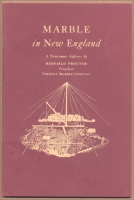 |
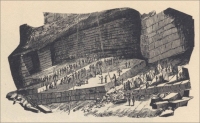 |
 |
Front cover of Marble in New England, by Redfield Proctor (probably 1950s) |
Sketch of marble quarry in Marble in New England |
Sketch of marble yard and shed in in Marble in New England |
 |
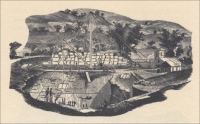 |
 |
Sketch of interior of marble quarry in in Marble in New England |
Sketch of marble quarry and yard in in Marble in New England |
Sketch of marble yard and derrick in in Marble in New England |
 |
 |
 |
Sketch of Baxter Manufacturing Co. marble yard and derrick in in Marble in New England |
Sketch of cutting shed in in Marble in New England |
Sketch of Rutland Marble Co. Mill, Center Rutland, Vermont, in Marble in New England |
 |
 |
 |
Sketch of Rutland Marble Co. Continental Mills - Turned Work & Tiles (marble yard and shed) in Marble in New England |
Sketch of Rutland Marble Co. marble yard, derricks, shed, and office in Marble in New England |
Sketch of Rutland Marble Co. Boston Yard, Rutland & Continental Marble (building marble, wall capping, tiles &c.) in Marble in New England |
- Proctor, Vermont – Marble
Sample Box by the Vermont Marble Company – The
below images of the marble samples, box, and accompanying literature
are also available for viewing in PDF.
Below are images of the top of a box of marble samples and images of the sample stones. The box was produced by the Vermont Marble Company of Proctor, Vermont. These stone samples were used in monument shops and by traveling agents to enable their customers to choose the type of marble they wished to use for their cemetery stones. The Vermont Marble Company was one of the largest suppliers of cemetery stones across the United States.
-
 Key to Samples:
(1) Verde Antique quarried at Roxbury,
Vermont. Commercially
this is known as a marble, but technically it is a serpentine – a
hydrous magnesium silicate rock. The serpentine forms
by action of volcanic waters upon an older igneous intrusive
and it is called a metamorphic rock. Used widely for
both exterior and interior work. (2)
Champlain Red quarried at Swanton, Vermont.
This is a dolomitic limestone formed by sedimentation
of calcareous sea life. Its broken shells of calcium
carbonate have been replaced by dolomite and their form
destroyed completely. The red color is due to the presence
of iron compounds. (3) Radio Black
is quarried at Isle La Motte, Vermont, in Lake Champlain.
This is a dolomitic limestone formed by sedimentation
of calcareous sea life. Fossils of shells are not uncommon.
The black color is bitumen. A notable installation is
in the NBC Building in Radio City. (4)
Neshobe Gray quarried at West Rutland, Vermont.
This very pure calcium carbonate rock owes its color
to finely divided graphite. The shell fragments of the
original limestone have been recrystallized into sparkling
calcite grains. (5) Pittsford Valley
quarried at Florence, Vermont. Like all the
calcite marbles, it is very pure and was a limestone
of sedimentary origin. The limestone was recrystallized
to the marble which is a highly metamorphic rock. It
is used extensively for memorials as well as for building
interiors and exteriors. (6) Danby
Imperial. One of several varieties quarried at Danby,
Vermont. It is
more highly recrystallized than either of the above
varieties. This pure calcium carbonate marble has been
used in many well known building exteriors – among
them are the Supreme Court Building, the Jefferson
Memorial, Washington, D.C. (7)
Light Cloud. (8) Brocadillo:
Two samples of different varieties of white marble,
sometimes with green marking from the largest marble
quarry in the world at West Rutland, Vermont. It is
over 99% pure calcite and the green markings are due
to traces of silicates in various forms. Many famous
building interiors are finished in this marble. See
the World’s Largest Marble Exhibit,
Vermont Marble Company, Proctor, Vt.
Key to Samples:
(1) Verde Antique quarried at Roxbury,
Vermont. Commercially
this is known as a marble, but technically it is a serpentine – a
hydrous magnesium silicate rock. The serpentine forms
by action of volcanic waters upon an older igneous intrusive
and it is called a metamorphic rock. Used widely for
both exterior and interior work. (2)
Champlain Red quarried at Swanton, Vermont.
This is a dolomitic limestone formed by sedimentation
of calcareous sea life. Its broken shells of calcium
carbonate have been replaced by dolomite and their form
destroyed completely. The red color is due to the presence
of iron compounds. (3) Radio Black
is quarried at Isle La Motte, Vermont, in Lake Champlain.
This is a dolomitic limestone formed by sedimentation
of calcareous sea life. Fossils of shells are not uncommon.
The black color is bitumen. A notable installation is
in the NBC Building in Radio City. (4)
Neshobe Gray quarried at West Rutland, Vermont.
This very pure calcium carbonate rock owes its color
to finely divided graphite. The shell fragments of the
original limestone have been recrystallized into sparkling
calcite grains. (5) Pittsford Valley
quarried at Florence, Vermont. Like all the
calcite marbles, it is very pure and was a limestone
of sedimentary origin. The limestone was recrystallized
to the marble which is a highly metamorphic rock. It
is used extensively for memorials as well as for building
interiors and exteriors. (6) Danby
Imperial. One of several varieties quarried at Danby,
Vermont. It is
more highly recrystallized than either of the above
varieties. This pure calcium carbonate marble has been
used in many well known building exteriors – among
them are the Supreme Court Building, the Jefferson
Memorial, Washington, D.C. (7)
Light Cloud. (8) Brocadillo:
Two samples of different varieties of white marble,
sometimes with green marking from the largest marble
quarry in the world at West Rutland, Vermont. It is
over 99% pure calcite and the green markings are due
to traces of silicates in various forms. Many famous
building interiors are finished in this marble. See
the World’s Largest Marble Exhibit,
Vermont Marble Company, Proctor, Vt.
Map of Vermont Marble Company Plants, quarries, mills & shops, & lumbering
from inside of the box of marble samples
 “Marked in red on this
map are the important Vermont plants of the Vermont
Marble Company.There are quarries in Isle La Motte,
Swanton, Roxbury, Florence, West Rutland and Danby – mills
or shops in Proctor, Center Rutland and West Rutland – power
stations in Weybridge, Beldens, Proctor and Center Rutland – lumbering
operations in Grafton and Windham.
“Marked in red on this
map are the important Vermont plants of the Vermont
Marble Company.There are quarries in Isle La Motte,
Swanton, Roxbury, Florence, West Rutland and Danby – mills
or shops in Proctor, Center Rutland and West Rutland – power
stations in Weybridge, Beldens, Proctor and Center Rutland – lumbering
operations in Grafton and Windham.“Outside the state, the Company has quarrying interest in Colorado, Missouri, Montana and Alaska. It has branches in nine American cities, one third of which are equipped with finishing plants.
“The chief interest, however, centers in Proctor, because there, in addition to the long line of wonder-working shops, the visitor has free access to the largest Marble Exhibit in the world.”
- Proctor, Vermont – Vermont Marble Company Booklet: Lettering in Marble: A few plates and a few words of explanation - all bearing on the subject of lettering as it applies to the memorial trade, issued by the Vermont Marble Company, Procter, Vermont. (booklet in PDF format)
- Proctor, Vermont - Marble Exhibit (circa 1967) (From Mining and Mineral Operations in the United States: A Visitor’s Guide, by Staff, Bureau of Mines, Area Mineral Resource Offices, U. S. Department of the Interior, Bureau of Mines, 1967, pp. 72.)
“Vermont is known in minerals centers for high quality ornamental stone.”
“Vt. 3 north of U.S. 4. - At Proctor, near Rutland, a marble exhibit is open to the public during the summer months. The various applications of marble are on display. Marble is quarried underground in Vermont.”
- Proctor, Vermont - the Vermont Marble Museum - the World’s Largest Marble Exhibit (present-day marble exhibit)
(From the web site) “Marble is an important Vermont natural resource - it has touched nearly everyone! We hope you enjoy our introduction to the exhibit. It’s your connection to the history, science and art of Vermont Marble! We have been presenting the past present and future of marble, as used in art, as building material and amazing world of everyday uses for more that 20 years!”
- Proctor, Vermont – Vermont Marble Co. Marble Exhibit – Postcard Folder (pdf) (no date of publication) (Some of the postcard photographs from the postcard folder are presented below. Use the pdf link in the preceding sentence to view the rest of the postcard photographs in the folder.)
- Proctor, Vermont - the Vermont Marble Museum - the World’s Largest Marble Exhibit (present-day marble exhibit)
 |
 |
 |
Outside cover of the Vermont Marble Co. Marble Exhibit postcard folder |
“Panorama view - Proctor Shops - Vermont Marble Company” |
“Main Office - Vermont Marble Company - Proctor, Vermont” |
-
“…The Vermont Marble Company has quarries in Vermont, Colorado and Alaska, besides importing from Europe. As the photographs reveal, marble is taken from the quarries – deeply hewn into the earth’s surface – in large blocks, then cut, shaped and polished for its various uses. Color and texture vary according to the geological history of the deposit from which it is taken.”
 |
 |
“Last Supper Carving in Marble Exhibit – Proctor, Vermont” |
“A carving on display at the Marble Exhibit, Vermont Marble Co., Proctor, Vermont, U.S.A.” |
- “The Carrara of America,” by Day Allen Willey, in Scientific American, Vol. XCI, No. 10, November 5, 1904, pp. 309, 317-318.
- Proctor, Vermont - Marble Quarry (The Philadelphia Museums) This photograph shows
a corner of one of the great quarries in what is the most important marble
producing section of the United States.
 There are in this
country other deposits of limestones, some of which are now being worked
and others which will produce very largely in the future, but the quarries
lying in the neighborhood of Rutland and Proctor, Vermont, produce annually
more handsome marble many times over than is taken out in all the rest
of America. This is due to the fine quality of stone in the quarries,
the improved and efficient methods of working and the convenient transportation
facilities which enable the stone to be easily put on the market. Old-fashioned
and laborious methods of quarrying and handling the stone have been entirely
displaced by the most modern machinery. The stone is too easily cracked
and broken to allow of blasting. It is therefore cut out of the beds,
in which it lies, by machines called "channelers". These consist
of rows of long chisels, set in a strong travelling framework. This gang
of chisels is arranged so that it is worked by machinery and vibrates
up and down cutting a channel or groove in any desired direction. When
the groove is sufficiently long and deep the channeler is set at work
in another place cutting a cross channel and the bottom is also perforated.
The block can then be easily split away by means of wedges. Blocks of
marble thus dislodged are lifted by cranes and derricks worked by steam
or electricity and carried rapidly and easily to the railroad cars for
transportation. The picture shows one large block of marble being thus
lifted to the surface of the ground. The clean-cut steps in the sides
of the quarry show plainly how the machines have cut away the marble in
great blocks. In the bottom of the quarry are some portable engines which
furnish power for the quarrying machinery. A few laborers have been engaged
in cleaning away the snow. At Proctor, Vermont, there are very extensive
works where large amounts of this marble are dressed to size for building
purposes before being shipped away. Much of it is sawed into slabs and
polished for ornamental work. Vermont produces some pure white marble,
a great deal of which is somewhat bluish in color, some which is variegated
and some which is almost jet black.
There are in this
country other deposits of limestones, some of which are now being worked
and others which will produce very largely in the future, but the quarries
lying in the neighborhood of Rutland and Proctor, Vermont, produce annually
more handsome marble many times over than is taken out in all the rest
of America. This is due to the fine quality of stone in the quarries,
the improved and efficient methods of working and the convenient transportation
facilities which enable the stone to be easily put on the market. Old-fashioned
and laborious methods of quarrying and handling the stone have been entirely
displaced by the most modern machinery. The stone is too easily cracked
and broken to allow of blasting. It is therefore cut out of the beds,
in which it lies, by machines called "channelers". These consist
of rows of long chisels, set in a strong travelling framework. This gang
of chisels is arranged so that it is worked by machinery and vibrates
up and down cutting a channel or groove in any desired direction. When
the groove is sufficiently long and deep the channeler is set at work
in another place cutting a cross channel and the bottom is also perforated.
The block can then be easily split away by means of wedges. Blocks of
marble thus dislodged are lifted by cranes and derricks worked by steam
or electricity and carried rapidly and easily to the railroad cars for
transportation. The picture shows one large block of marble being thus
lifted to the surface of the ground. The clean-cut steps in the sides
of the quarry show plainly how the machines have cut away the marble in
great blocks. In the bottom of the quarry are some portable engines which
furnish power for the quarrying machinery. A few laborers have been engaged
in cleaning away the snow. At Proctor, Vermont, there are very extensive
works where large amounts of this marble are dressed to size for building
purposes before being shipped away. Much of it is sawed into slabs and
polished for ornamental work. Vermont produces some pure white marble,
a great deal of which is somewhat bluish in color, some which is variegated
and some which is almost jet black. - Proctor, Vermont – “A Vermont Marble Quarry,” Harpers’ Weekly Journal of Civilization, New York, November 21, 1903, pp. 1856.
“A Vermont Marble Quarry” at Proctor, Vermont, Harpers' Weekly, November 21, 1903 
- Proctor, Vermont - the Proctor Marble Quarry - Vermont Marble
Company (from Commercial
Marbles of Western Vermont, Bulletin 521, by T. Nelson Dale, United
States Geological Survey, Government Printing Office, Washington, D.
C., 1912.)
“The Proctor quarry, in full operation in 1900 but idle since 1907 and full of water in 1910, is about 0.4 mile northwest of Proctor station, on the north side of the village, a mile north of the Columbian quarry. (See Pl. I.) It is about 200 feet square, with an offset on the east side, and in 1900 was 175 feet deep. Owner, Vermont Marble Co., Proctor, Vt.
“Marble 70 to 185 feet thick is exposed, lying between the uppermost bed of the dolomite, series on the east and the intermediate dolomite on the west.
“The marble, ‘Sutherland Falls’ (specimens D, XIX, 140, c, d), is a calcite marble of bluish-white color with thin dark-gray spots and bands, probably dolomitic, along the bedding plane. Its texture is uneven and of grade 5 (coarse). It resembles very closely the ‘Riverside; Marble, described on page 126.
“The general structure I shown in section G, Plate III. The marble beds form the eastern limb of a syncline about 150 feet in depth, but instead of curving over directly on the east to form an anticline, they turn sharply to dip at a low angle to the east for a space of 50 feet and then turn again to resume the direction of the synclinal limb. The effect of this minor fold in the anticlinal part of the fold is to double over some of the marble beds in the lower eastern part of the quarry and reduce the apparent thickness. Between 1900 and 1907 the quarry was also worked toward the east. The section on the north wall of this eastern extension shows the eastward-dipping beds of this minor and easterly overturned fold crossed by low eastward-dipping joints, along which several caves as much as 3 feet in height have been eroded by percolating water. The dolomite which overlies the marble on the west differs microscopically from that of the dolomite series which underlies it on the east. (See p. 30.)
“It is reported that the reasons for abandoning this quarry were the abundance of joints and the thinning of the beds at the turn of the syncline.”
- Proctor, Vermont - the Shangrow Marble Quarry - Vermont Marble
Company (from Commercial
Marbles of Western Vermont, Bulletin 521, by T. Nelson Dale, United
States Geological Survey, Government Printing Office, Washington, D.
C., 1912.)
“The Shangrow quarry, abandoned between 1900 and 1910, is 1 ¼ miles north-northwest of Proctor station and 1 ½ miles N. 15° W. of the Proctor quarry, in Proctor Township. (See Pl. I.) Owner, Vermont Marble Co., Proctor, Vt.
“The marble beds exposed in 1900 consisted, beginning at the top, of 32 feet of banded graphitic marble overlying 14 feet of graphitic quartzose dolomite veined with quartz, under which was an unknown thickness of banded marbles like those above it. The beds belong to the upper Graphitic series of the marble formation.
“The marble, ‘mountain dark’ (specimen D, XIX, 149, B, C, rough), is a graphitic banded calcite marble of alternating dark-gray to black and light bluish-gray bands (beds) ranging from 0.1 to 0.3 inches in width and of uneven and irregular texture, with grain diameter of 0.05 to 0.62, mostly 0.12 to 0.37 millimeter, and thus of grade 4 (medium); one grain seen measured 0.37 by 2.37 millimeters. In the graphitic bands the calcite grains are generally of smaller diameter, ranging from 0.05 to 0.17 millimeter. The marble contains small quartz particles, small cubes of pyrite, quartz lenses up to 0.37 millimeter in diameter, and in the dark bands abundant graphite. Some bands are muscovitic and pyritferous.”
-
Proctor, Vermont – Vermont Marble Company (Advertisement from Through The Ages, Vol. 5, No. 8, December 1927, pp. 45)
Vermont Marble Co., Proctor, Vermont – Branches in the larger cities
See Sweet’s Catalog for Specifications and Other DataWith the Banks in Hawaii: Banking institutions, following trade in its world-wide development, necessarily must be established in many remote geographical localities, but regardless of distance they continue to use marble as a part of their equipment….”
“Hawaii, in mid-ocean, is served by local banks, many having their share of marble. At Honolulu, the Bishop Bank was fitted with Vermont and Tennessee marbles. John Mason, architect.”
-
Proctor, Vermont – Vermont Marble Company Quarries, Mill, and Yard – The following photographs are from The Marble Industry of Vermont, Free Press Printing Co., Burlington, Vermont, No date of publication – early 1920s. (A few of the photographs and part of the introduction to the booklet can be found below. You can read the entire booklet by using the link near the beginning of this paragraph.)
“Not long after the close of the Revolutionary War, someone discovered that the ledges of Vermont could be made to produce good fireplace stones. In 1790, after Jonas Stewart had turned one of the quarry slabs into a tombstone, people began to see that the product was really valuable. Thus was the first American marble quarry opened and a great industry started.
“For nearly a hundred years, many different men tried in vain to place the Vermont marble industry on a stable basis. Something always seemed to stand in the way. The first real advance came about forty years ago, when the organization at Sutherland Falls, became known as the Vermont Marble Company. Under that name the business fought its way into an era of prosperity.
“In the seventies, there was only one quarry in operation, and all the blocks were hauled to the mills by oxen. A few scattered houses stood where the village of Proctor now stands. Today, the site of that old mill is marked by a huge group of modern structures, the largest marble manufacturing company in the world.
“What are some of the things that have gone into the making of the Vermont Marble Company? First of all, there are seventy-five or more quarries with a combined yearly output of about 1,000,000 cubic feet. There are shops and mills in Proctor 1,500 feet in length, with other plants at Center Rutland, West Rutland, Florence, Brandon, Middlebury, Swanton, Roxbury, Danby, Dorset, Manchester, Bluff Point, N. Y. (New York), San Saba, Tex. (Texas), and Tokeen, Alaska. There are branches in the larger cities, many of which are equipped for finishing marble. There are about fifty traveling salesmen….”
| “...At Honolulu, the Bishop Bank was fitted with Vermont and Tennessee marbles. John Mason, architect.” (Advertisement from Through The Ages, December 1927, pp. 45) |  |
 |
 |
 |
Front cover of The Marble Industry of Vermont (early 1920s) |
“The Proctor Plant of Today with a Marble Yard Covering Eleven Acres.” |
“Moving Marble Three Hundred and Fifty Feet Underground.” |
 |
 |
 |
"Starting Marble Block From Quarry" |
“Sawing Fifty-Two Slabs from Marble Block” |
“Marble on the Rubbing Bed” |
 |
 |
“Cutting Marble Block from Floor of Quarry.” |
“A Marble Caver at Work” |
Proctor, Vermont – the Vermont Marble Company – Price List of Monumental Marble, Effective September 1, 1946, Price List for Design Book No. 21, Vermont Marble Company, Proctor, Vermont.
- Vermont Marble Company Whole Sale Price List of Monumental Marble, Effective January 3, 1950, Vermont Marble Company, Proctor, Vermont (Branches: Chicago – 1105 West Lawrence Avenue; Cleveland – 1737 Euclid Avenue; Dallas – 1513 Wall Street; New York – 101 Park Avenue; Philadelphia – 1524 Chestnut Street; San Francisco – 525 Market Street)
 |
 |
 |
Title page of the Vermont Marble Co. Price List of Monumental Marble, Effective Sept. 1, 1946 (Price List for Design Book #21) |
Pages 32 & 33 of the Vermont Marble Co. Price List of Monumental Marble, Effective Sept. 1, 1946 (Price List for Design Book #21) |
Pages 6 & 7 of the Vermont Marble Co. Price List of Monumental Marble, Effective Sept. 1, 1946 (Price List for Design Book #21) |
 |
 |
 |
Front cover of the Vermont Marble Co. Wholesale Price List of Monumental Marble, Effective January 1, 1950 |
Index for the Vermont Marble Co. Wholesale Price List of Monumental Marble, Effective January 1, 1950 |
Pages 2 & 3 listing the varieties of monumental marble (Vermont Gray, Pittsford Valley, & Rutland White) in the Vermont Marble Co. Wholesale Price List of Monumental Marble, Effective January 1, 1950 |
Commercial use of material within this site is strictly prohibited. It is not to be captured, reworked, and placed inside another web site ©. All rights reserved. Peggy B. and George (Pat) Perazzo.






















